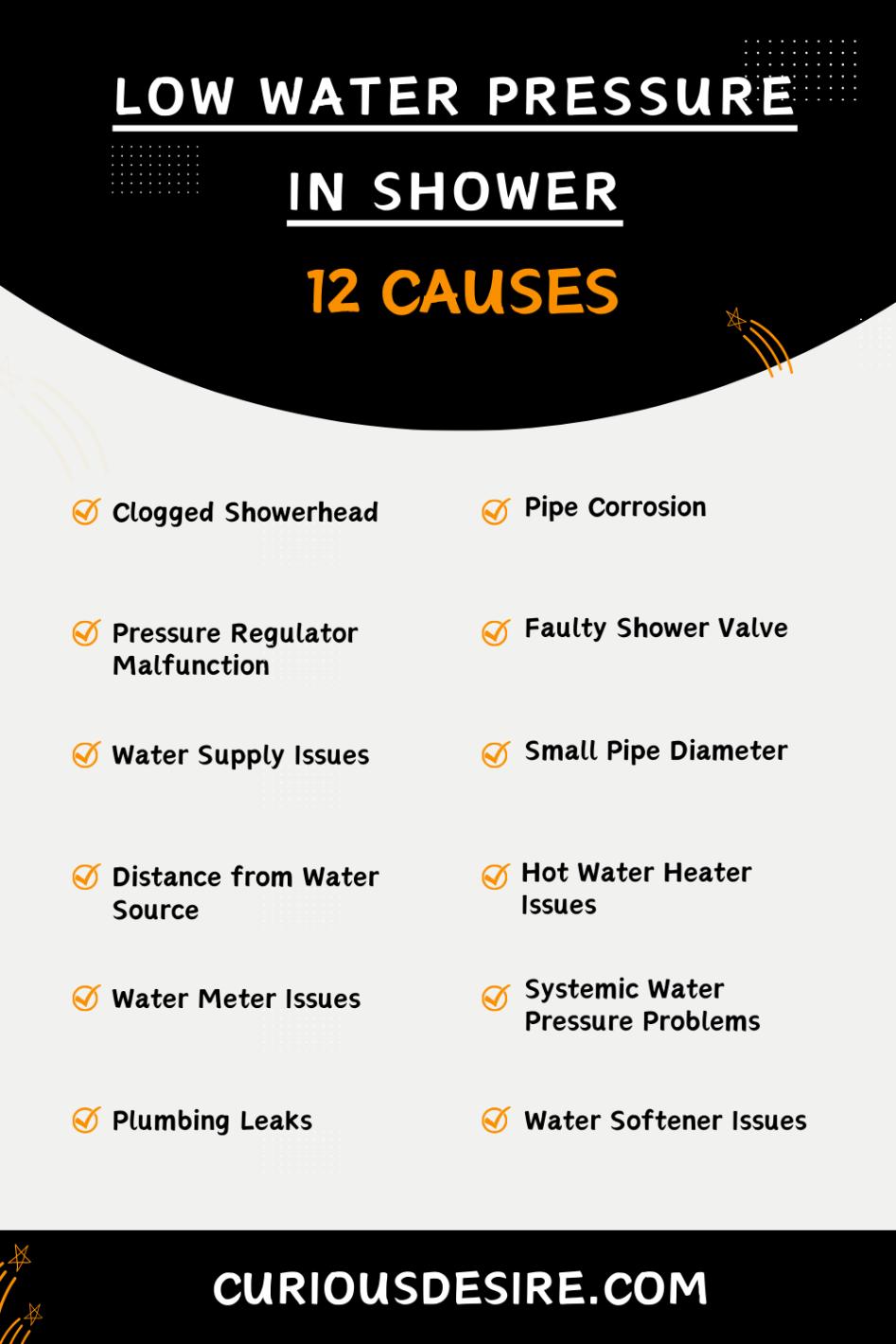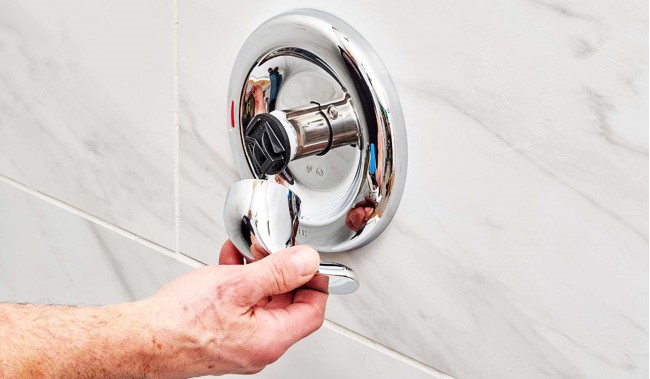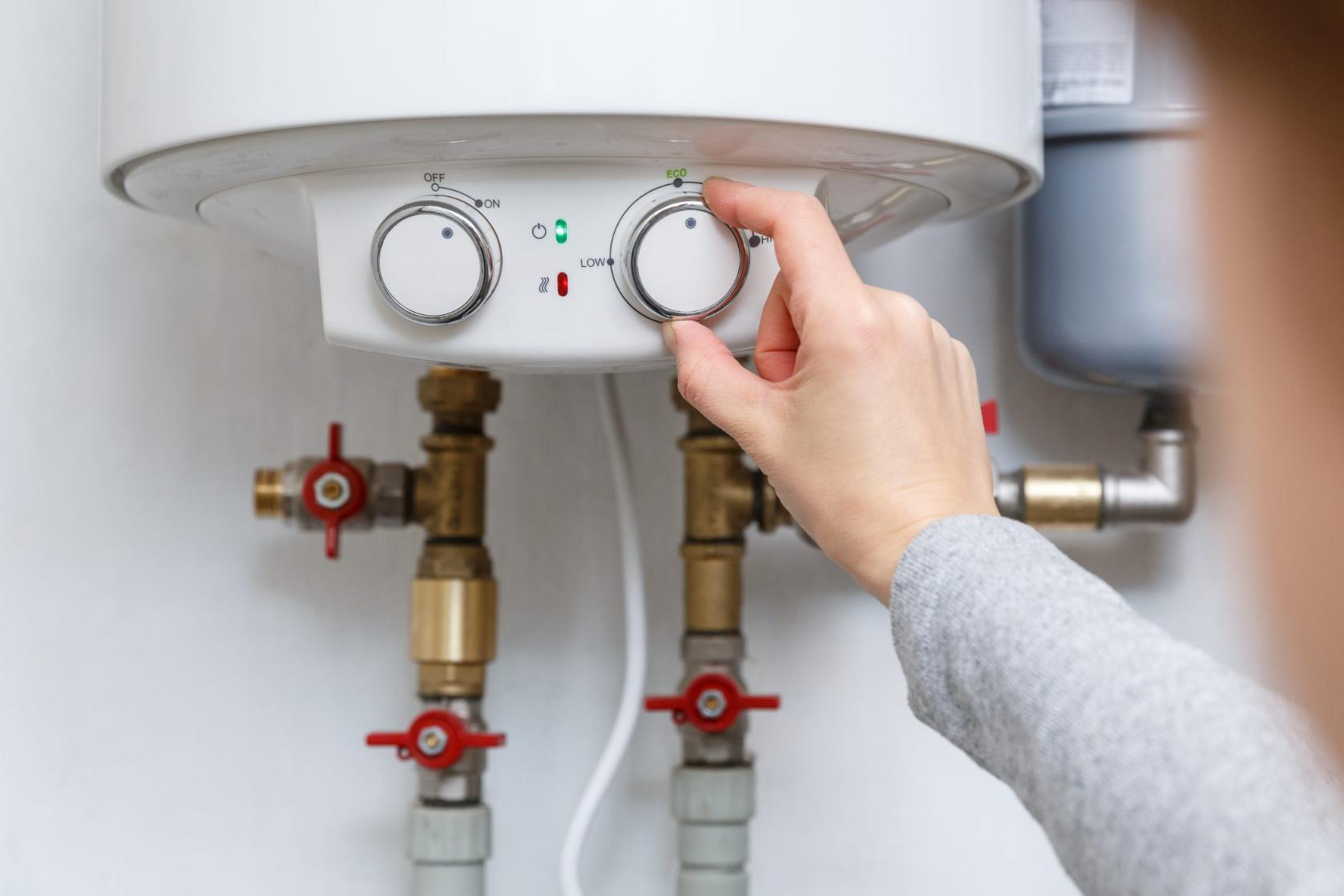Low water pressure in the shower can disrupt your daily routine and diminish the quality of your showering experience.
Identifying the root causes of this issue is essential for finding effective solutions.
In this article we’ll discuss the causes of low water pressure in showers, offering insights and practical tips to improve water pressure and enhance your showering comfort.
Here are the top 5 causes of low water pressure in showers:
- Clogged Showerhead
- Water Supply Issues
- Systemic Water Pressure Problems
- Plumbing Leaks
- Hot Water Heater Issues
[toc]

Cause 1: Clogged Showerhead
Over time, mineral deposits and sediment can accumulate within the showerhead, obstructing the spray nozzles and impeding water flow.
This buildup often manifests as reduced water pressure during showers. Regular cleaning or descaling of the showerhead can effectively address this issue.
Simple remedies such as soaking the showerhead in vinegar or using a small brush to scrub away deposits can restore proper water flow.
It’s advisable to perform this maintenance periodically to prevent significant buildup and maintain optimal shower performance.
Cause 2: Pipe Corrosion or Blockages
The plumbing pipes in your home can develop issues such as corrosion, rust, or blockages over time.
These problems can impede the flow of water to your shower, resulting in low water pressure.
Professional inspection and maintenance of the plumbing system are essential to identify and address these issues effectively.
Depending on the severity of the problem, solutions may include cleaning out blockages, repairing corroded pipes, or even replacing sections of the plumbing system.
Cause 3: Pressure Regulator Malfunction
The pressure regulator is responsible for controlling the water pressure entering your home from the main water supply.
If the regulator malfunctions, it can lead to either excessively high or insufficient water pressure throughout your plumbing system.
A qualified plumber can inspect the pressure regulator to diagnose any issues and make necessary adjustments or repairs.
Properly functioning pressure regulation is crucial for maintaining consistent and appropriate water pressure levels in your home.
Cause 4: Faulty Shower Valve
The shower valve regulates the flow and temperature of water to your showerhead.
If the valve is faulty or partially closed, it can restrict water flow and result in reduced water pressure during showers.
Replacing the shower valve may be necessary to restore proper water flow and pressure.
It’s essential to ensure that the new valve is installed correctly and functions properly to prevent future issues with water pressure in your shower.
Cause 5: Water Supply Issues
Temporary decreases in water pressure can occur due to municipal water supply problems such as water main breaks, maintenance activities, or periods of high demand.
Contacting your water provider can help determine if such issues are affecting your water pressure.
While these problems are typically resolved quickly, it’s essential to stay informed and take appropriate measures to mitigate any inconvenience caused by low water pressure during these instances.
Cause 6: Small Pipe Diameter
The diameter of the pipes supplying water to your shower can impact the flow rate and water pressure.
If the pipes are too small, they can restrict water flow and lead to low water pressure in the shower.
Replacing these pipes with larger ones can improve water flow and increase water pressure.
Cause 7: Elevation or Distance from Water Source
Homes located at higher elevations or farther from the main water source may experience lower water pressure due to gravitational forces or distance-related pressure loss.
Installing a booster pump can help increase water pressure in such cases by providing additional force to push water through the plumbing system.
Booster pumps are especially beneficial for homes situated in areas with consistently low water pressure, offering a reliable solution to improve water flow in showers and other fixtures.
Cause 8: Hot Water Heater Issues
Problems with the water heater, such as sediment buildup, a faulty pressure relief valve, or a malfunctioning heating element, can affect water pressure.
Regular maintenance of the water heater is essential to prevent these issues.
Flushing the tank periodically, inspecting and replacing faulty components, and ensuring proper temperature and pressure settings can help maintain optimal water pressure and heating performance.
Cause 9: Water Meter Issues
Malfunctioning water meters or valves near the meter can affect water pressure in your home.
If the water meter is faulty or incorrectly calibrated, it may not accurately regulate water flow, leading to fluctuations in water pressure.
Contacting your water utility provider can help address these issues by requesting a meter inspection or replacement.
Ensuring that the water meter and associated components are functioning correctly is crucial for maintaining consistent water pressure throughout your plumbing system.
Cause 10: Systemic Water Pressure Problems
In some cases, low water pressure may be a systemic issue in the neighborhood or community, affecting multiple homes.
Factors such as aging infrastructure, high demand, or maintenance activities on the water supply system can contribute to widespread water pressure issues.
Contacting neighbors or local authorities can help identify and address such problems collaboratively.
Working together with community members and relevant stakeholders, such as water utility providers or municipal authorities, can lead to solutions that improve water pressure for everyone affected.
Cause 11: Plumbing Leaks
Undetected leaks in the plumbing system, including pipes leading to the shower, can lead to water loss and reduced water pressure.
Detecting the plumbing for leaks and promptly repairing them is essential to prevent further damage and restore proper water flow.
Common signs of plumbing leaks include water stains, dampness, or mold growth near pipes or fixtures.
Addressing leaks promptly not only helps maintain water pressure but also conserves water and prevents potential water damage to your home.
Cause 12: Water Softener Issues
Homes equipped with water softener systems may experience low water pressure due to problems such as clogs in the softener resin tank or low salt levels.
Checking and maintaining the water softener system regularly can help prevent these issues and ensure optimal water pressure.
Periodically cleaning or replacing the resin tank, replenishing salt levels as needed, and scheduling professional maintenance can help maintain water softener performance and prevent disruptions to water pressure.
Low Water Pressure In Shower Causes – FAQs
1. How do I fix low water pressure in my shower?
To fix low water pressure in your shower, you can try several troubleshooting steps. Start by checking for clogs in the showerhead and cleaning or descaling it if necessary.
Inspect the plumbing pipes for any blockages or leaks and repair them as needed. Ensure that the shut-off valve supplying water to the shower is fully open.
If these steps don’t resolve the issue, consider consulting a plumber to diagnose and address any underlying problems with the plumbing system.
2. What is the cause of low water pressure?
Low water pressure in a shower can be caused by various factors, including clogged showerheads, pipe corrosion or blockages, malfunctioning pressure regulators, faulty shower valves, water supply issues, small pipe diameter, elevation or distance from the water source, water heater issues, systemic water pressure problems, and more.
3. How can I make my water pressure stronger?
To make your water pressure stronger, you can try adjusting the pressure regulator, cleaning or replacing clogged showerheads, ensuring that the shut-off valve supplying water to the shower is fully open, inspecting and repairing any leaks or blockages in the plumbing system, and installing a booster pump if necessary.
Consulting a plumber can help determine the most effective solution for increasing water pressure in your shower.
4. Why is there no water in my shower but plenty everywhere else?
If there is no water in your shower but plenty everywhere else in the house, it could indicate a problem specific to the shower’s plumbing.
Potential causes may include a closed or partially closed shut-off valve, a clogged showerhead or pipe, a malfunctioning shower valve, or a plumbing leak in the shower system.
Inspecting these components and addressing any issues should help restore water flow to the shower.
5. Where is my shower mixing valve located?
The shower mixing valve, also known as the shower valve or faucet valve, is typically located behind the shower wall.
It connects to the hot and cold water supply pipes and regulates the flow and temperature of water to the showerhead.
Accessing the shower mixing valve usually requires removing the shower trim or access panel to reach the valve assembly for maintenance or repairs.
6. How do I know if my shower valve is broken?
Signs of a broken shower valve may include leaks around the valve assembly, difficulty adjusting the water temperature or flow, inconsistent water pressure, or the inability to shut off the water completely.
If you notice any of these issues or experience other problems with your shower valve, it may be broken or malfunctioning, and you should consider having it inspected and repaired by a qualified plumber.
7. How do you test a shower valve?
To test a shower valve, start by turning on the water supply to the shower and observing the flow and temperature of water. Test both hot and cold water settings to ensure they function correctly and adjust smoothly.
Check for leaks around the valve assembly and listen for any unusual noises, such as rattling or grinding, when operating the valve. If you encounter any problems during the test, it may indicate issues with the shower valve that require further inspection and repair.
8. Do I need a plumber to replace a shower valve?
Replacing a shower valve typically requires advanced plumbing skills and specialized tools, so it’s advisable to hire a professional plumber for this task. A plumber can safely remove the old valve, install a new one, and ensure that it functions correctly.
Attempting to replace a shower valve without the necessary expertise could result in damage to the plumbing system or improper installation, leading to further problems down the line.
9. What is the life of a shower valve?
The lifespan of a shower valve can vary depending on factors such as usage frequency, water quality, and maintenance practices.
Generally, a well-maintained shower valve can last anywhere from 10 to 20 years or more.
However, if the valve experiences excessive wear and tear, corrosion, or internal damage, it may need to be replaced sooner.
Regular inspection, cleaning, and maintenance of the shower valve can help prolong its lifespan and ensure reliable performance over time.
Resources Consulted
- How to Increase the Water Pressure in Your Shower – Mira Showers
- Reddit – Ask a Plumber
- R-Pod 195 Shower Water Pressure – Forest River Forums
- Will the Water Pressure Be Stronger if the Shower Head is Bigger? – Quora
- Increasing Water Pressure to Shower Head – Physics Stack Exchange
- How Can I Up the Water Pressure in My Shower? – Garage Journal Forum

